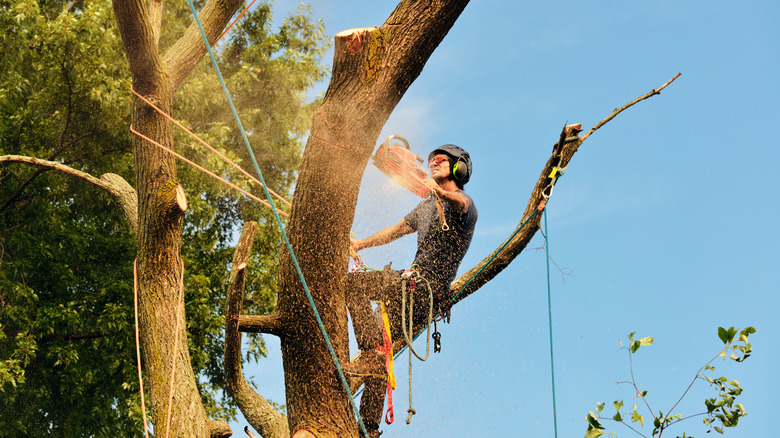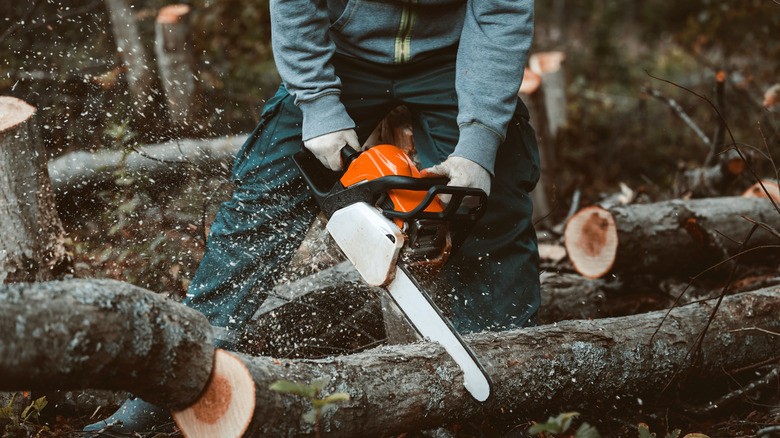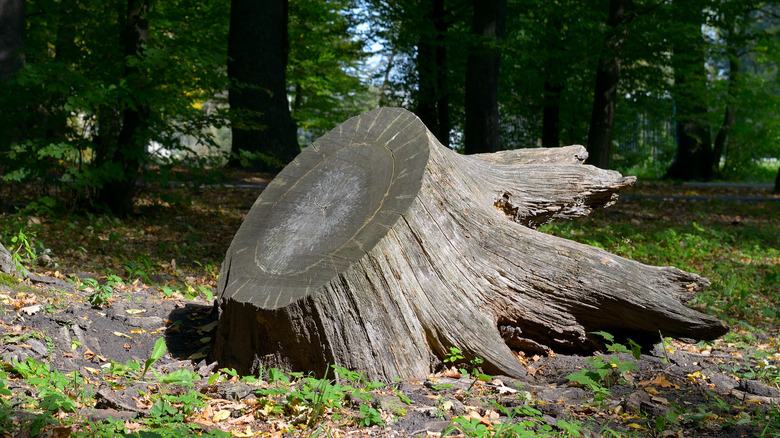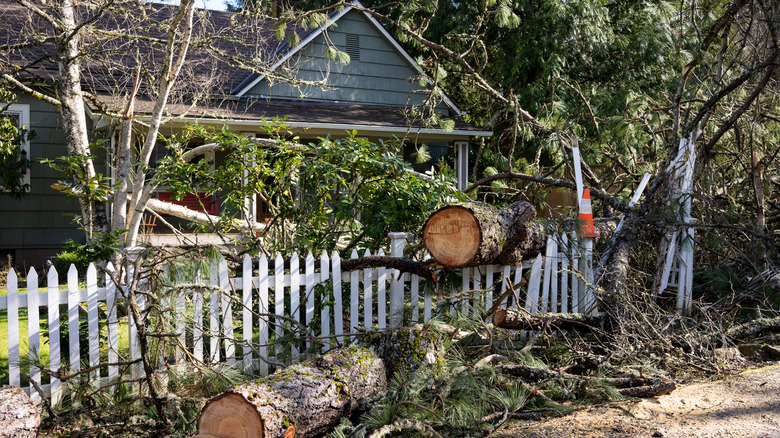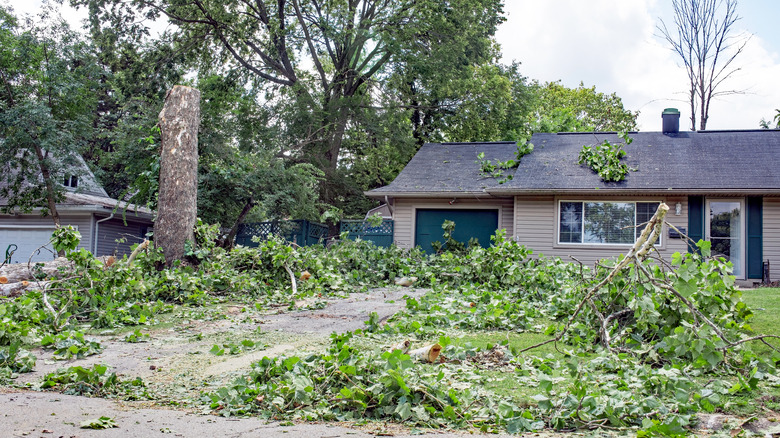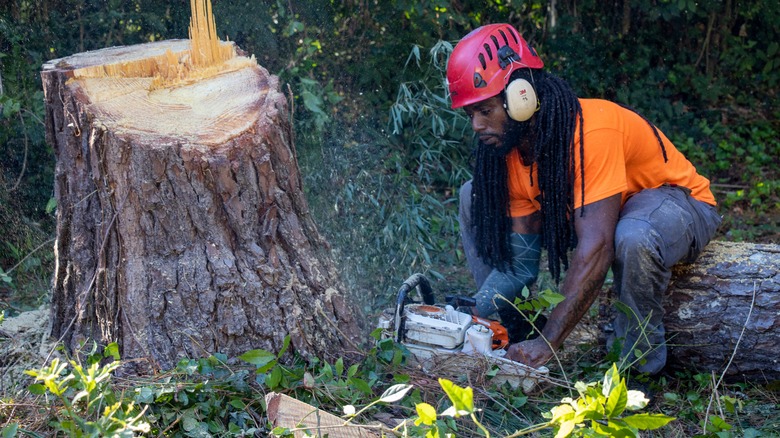How Much Does It Cost To Remove Trees From Your Yard
Trees provide shade and fantastic visual appeal on properties all across the United States. Homes that incorporate tree cover as a primary feature of their landscaping design are some of the most beautiful in the entire country (via Homes & Gardens). But there may come a time when you need to remove a tree from the yard. Tree trimming is a typical project for the average homeowner but removing one may be foreign to all but the most active home landscapers.
Angi estimates tree removal service costs ranging from $200 to over $2,000. Truly, the price you'll pay to take a tree away from your property depends on the size, hardness, and location of the trunk. Trees are all unique in their own ways, and these complexities all play a role in the overall cost.
Tree removal can come as a result of landscaping changes that you intend to make to the exterior of the home, or as a safety precaution designed to protect your house and family from a diseased or dying tree that has branched out over the roof. Tree removal—under optimal conditions—can be managed as a DIY project, but this is ill-advised when it comes to large trees or those positioned in areas of the yard that pose an increased threat of harm to the home or the people conducting the removal (namely, you).
Factors for cost
If you're thinking of removing a tree from your yard, there are a few factors that will play a major role in the overall cost of the project. Above all else, the scope of the project in terms of tree size and number to be removed and the physical location where your home exists feature heavily in the price.
Location plays a major role in the overall price
Location comes into play in two different ways. First of all, Angi reports that average costs can vary by state and generalized geographic location, with averages ranging from $350 to $650 in Colorado to $750 all the way up to $1,500 in Florida, for instance.
These price differences are due to a number of localized environmental factors and the potential for permit requirements, disposal regulations, and other local laws that govern this type of property alteration.
As well, the physical location that a tree is positioned on your property can affect the tools required as well as the number of additional crew members to get the job done, potentially altering the cost. Tree branches are much heavier than they appear, and an accidental fall on your roof or a car can cause significant damage, even from a smaller section. Professionals often employ ropes and directional cuts to ensure that the segments fall in the desired direction. The physics involved in felling an unwanted or dangerous tree dictate how many workers you might need for any particular job in order to complete the task safely—which is the most important aspect of the process (via Family Handyman).
Tree size and number will affect the cost
As well as location-based factors, cutting down a large tree will take longer than chopping down a small tree. This results in a higher price tag for the work as well. A big tree requires the same kinds of additional care that cutting one in a precarious position warrants as well. Both of these features make a larger tree more expensive to cut down, regardless of the state or region that you call home.
Tree size is often used as a metric for cost above other elements of the job, with a cost per foot calculation employed by many professionals who work in this industry; you can expect to pay as little as $8 per foot for the smallest trees and about $15 per foot for larger ones (via Angi).
Additional costs
Location and project size aren't the only things that dictate the overall price for tree removal services, though. There are a few additional considerations to be made when going ahead with a tree extraction from your yard.
Stump removal and root system eradication are distinct services
A tree removal professional may include the cost to remove the stump and remaining root system or not (via Bob Vila). It's important to find out whether your quote includes this service when hiring a team to remove one or more trees from your property.
Taking the stump out will add an average of about $327 to the overall cost—if it isn't already included in your quote (via Bob Vila). A professional landscaper may use specialized machinery to rip out the leftover stump once the tree has been hauled away, or they might utilize a drilling and chemical application technique instead. Bob Vila reports that burning out a stump with potassium nitrate or deploying other chemical rotting agents will typically cost about $100 per stump.
Of course, you can take on this project yourself, but you should be prepared to spend nearly as much (if not more) to conduct this process without professional assistance.
The type of tree in question can also alter the price
Tree Triage reports that different kinds of trees come along with distinct price tags. Denser, hardwood trees will cost more to remove than pine or palm trees because they involve much more work than the removal of a tree sporting a softer trunk.
Hardwoods also branch out far more rapidly than other tree varieties. Oaks, maples, and elms quickly establish a thick trunk and a wide canopy of branches that must be contended with before the main thrust of the tree can be taken down (via Angi). For large hardwoods, your tree removal specialist will likely need to get up into the branches and remove some of the larger limbs—potentially with the help of complex roping and even a cherry picker to get into the proper position. A more complex removal job will amplify the price.
A few notes about removing trees yourself
Some homeowners may want to remove trees on their own to cut down on the cost of the project. By removing a tree yourself you can save a few hundred or even thousands of dollars, yet tree removal is a time-consuming and often dangerous task. While it is certainly possible to do so on your own, you should only undertake this project if you are experienced and confident in your ability to successfully fell any target trees in your yard. As well, you should only really consider tackling tree removal yourself if you are facing off against smaller trees—old, large oaks and other sprawling foliage in the yard should always be handled by a professional team.
Tree Triage suggests that many homeowners can take on this task by themselves if they are well-versed in the use of a chainsaw or mattocks (for the true hand tool approach).
Safety considerations
The most important consideration to make when thinking about removing a tree on your own is one of safety. A falling tree can severely injure you or someone else, so taking the hazards involved in this task seriously is the first step to getting the job done right. It's always a good idea to use ear protection when employing power tools, and whether you're swinging an ax or mattocks, or using a chainsaw to complete the job, eye protection is a must to prevent flying debris from hitting your eyes or face (via Firewood for Life).
Equipment costs
Angi estimates that a chainsaw will cost you between $50 and $150, while wedges come in at around $20 for a pack. You can also expect to see a total price of about $200 to $300 for the range of protective equipment that you'll want to use while removing the tree.
Time requirements
Do It Yourself suggests that the average tree can be chopped down in two to five hours with hand tools. This timeline is shortened considerably while using a chainsaw, but the main removal of the tree is only the beginning. If you opt to take down a tree on your own, you'll also have to look after the stump removal process after the tree has been successfully removed. While the task can be immensely satisfying for someone who likes to tackle home improvement on their own, the time commitment involved in completely removing a tree from your yard can be lengthy.
Why you need to make use of a tree removal service
Tree removal serves homeowners in a few key areas. From foundation security to the ability to reduce ants, insects, and other pests from entering your home with ease, strategically altering your lawn's design by removing a tree can make a massive difference in your quality of life.
Protecting the foundation of your home
A tree that has been planted directly adjacent to your home can pose a threat to the foundation if its root system has started to branch out horizontally (via SFGate). A wide, shallow root pattern is easily visible on a large tree, and this type of rooting can eventually crack your concrete foundation if left unchecked. Removing a hazardous tree is a responsibility that homeowners have, and calling in a professional to take out this type of problem is the best course of action here.
Removing a highway for pests to enter your home
In addition to problems that can affect the foundation of your property, a tree that's grown too close to the home offers an easy entryway into your home for pests. Ants, rodents, and other critters use tree branches to make their way onto the roofs of residential and commercial properties alike. From there, crawling inside the attic space is simple for a determined intruder of this size (via Greenawalt Roofing).
Many homeowners find success with careful trimming of problematic tree branches, but a growing oak or elm tree can eventually outgrow your ability to tame these types of branches. With the weight of an older oak tree's branches leaning precariously over your home, it can be a daunting task to cull all but the smallest of branches without professional help.
Instead of conducting yearly trimmings, it's likely a better option to remove the troublesome tree altogether—perhaps in favor of planting newer additions in a more favorable spot that can give way to more advantageous shading for your outdoor relaxation spaces.
Benefits of tree removal and new landscaping design
In addition to the technical benefits that result from the removal of a poorly placed tree, there are some aesthetic changes that make a big difference in your home's visual and emotional presence, too.
Significant landscaping alterations make for a more appealing exterior space
Removing trees that aren't beautifying your landscaping can be a major update for a home that's lacking in overall curb appeal. The New York Post reports on a study put out by lawn care equipment supplier Cub Cadet, suggesting that Americans spend an average of 32 hours per month tackling lawn care tasks and an additional three hours contemplating the lawn. But tree and stump removal often filter through the cracks when it comes to lawn maintenance and upkeep.
Taking out a diseased tree that has become a visual blight on your property's otherwise immaculate lawn is the perfect way to turn the corner when it comes to perfecting your lawn's visual presence in the neighborhood.
Tree removal and associated landscaping tasks can increase your home's resale value
Grasshopper Gardens estimates that a revamp of your outdoor landscaping can provide a return on investment that ranges from 200% all the way up to 400%. This comes with a significant dedication to the transformation of your exterior space. However, routine maintenance that keeps the yard looking clean and groomed can make up as much as 28% of your home's total value, even without an overwhelming contribution to the space.
Taking out an unwanted tree from the yard can brighten up the exterior of your home and completely rejuvenate its aesthetic, and targeting an ugly, diseased, or ill-placed tree can change the financial calculation of your property for the better.
